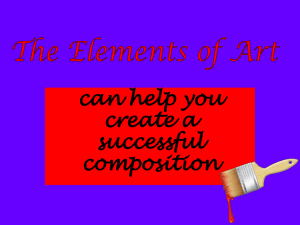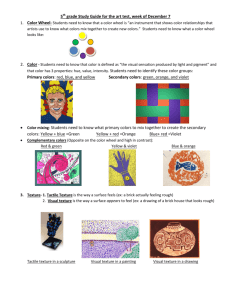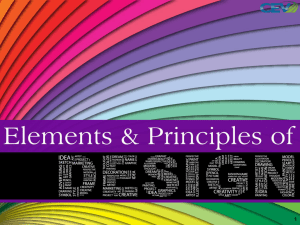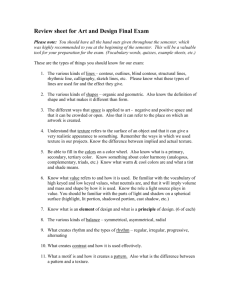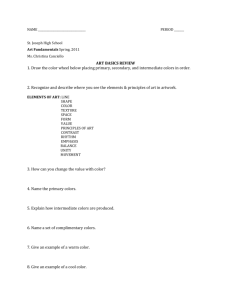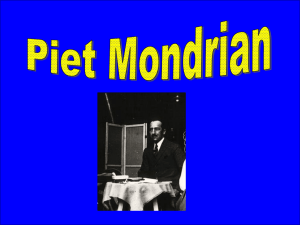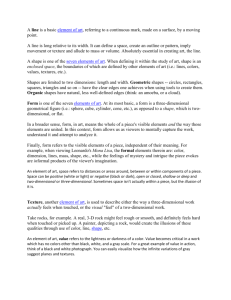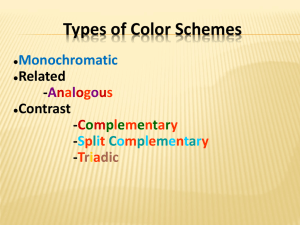VISUAL ART
advertisement
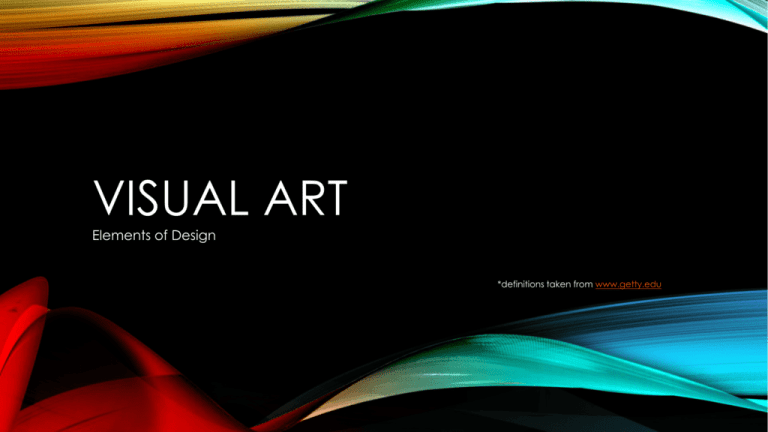
VISUAL ART Elements of Design *definitions taken from www.getty.edu ELEMENTS . • TODAY I can: • identify the elements of art and evaluate their role in the compositions of a work of art. • better understand an artist’s choices. • be better equipped to address whether a work of art is successful, and why ELEMENTS • Line • Shape • Color • Form • Value • Texture • Space • Media LINE *An identifiable path created by a point moving in space *Define edges of a form *Lead your eye around the composition *Can communicate information through their character and direction LINE • Horizontal lines suggest a feeling of rest or repose because objects parallel to the earth are at rest • They can also show a sense of depth LINE • Vertical lines communicate a sense of height because they are perpendicular to the earth extending upwards toward the sky. LINE • Diagonal lines convey a feeling of movement and instability LINE • The curve of a line can convey energy and movement. EXAMPLES OF LINE SHAPE AND FORM define objects in space * Shapes have two dimensions-height and width *Form exists in three dimensions, height, width, and depth * are usually defined by lines * basis for sculpture, furniture and decorative arts Organic Geometric Shape Form EXAMPLES COLOR Light reflected off objects • Color has three main characteristics: • hue (red, green, blue, etc.) • value (how light or dark it is) • intensity (how bright or dull it is) • Colors can be described as warm (red, yellow) or cool (blue, gray), depending on which end of the color spectrum they fall. THE COLOR WHEEL First invented by Sir Isaac Newton in 1666 and later improved by countless others, color wheel shows how primary colors blend to create other distinct hues COLOR THEORY Color Theory-- a body of practical guidance to color mixing and the visual effects of a specific color combination • http://www.colormatters.com/color-and-design/basic-color-theory PRIMARY COLORS SECONDARY COLORS INTERMEDIATE/TERTIARY COLORS COLOR WHEEL PROJECT • Must include all colors on the color wheel • Must be a mosaic style project (torn pieces of magazines) • Must not be able to identify pictures/words, etc. from magazine pieces • No white spaces • Must create a unique design for the final product • Must be as large as or larger than a sheet of notebook paper • Must be framed/mounted on black construction paper • Final product will be worth up to 100 test points • Due Friday, January 30 at the end of class TEXTURE • The surface quality of an object that we sense through touch • All objects have a physical texture • Artists can also convey texture visually in two dimensions • • TEXTURE DEPICTED IN TWO DIMENSIONS Artists use color, line, and shading to imply textures -gives a visual sense of how an object depicted would feel in real life if touched -hard, soft, rough, smooth, fuzzy, leathery, sharp, etc IN THREE-DIMENSIONAL WORKS • artists use actual texture to add a tactile quality to the work VALUE • The lightness or darkness of a color • The key to the illusion of light (http://thevirtualinstructor.com/Value.html) SPACE • Real space is three-dimensional. • Space in a work of art refers to a feeling of depth or three dimensions. • It can also refer to the artist's use of the area within the picture plane. PERSPECTIVE POSITIVE AND NEGATIVE SPACE • The area around the primary objects in a work of art is known as negative space • The space occupied by the primary objects is known as positive space MEDIUM/MEDIA • a medium is a material used by an artist or designer to create a work • mixed media or mixed-media - A technique involving the use of two or more artistic media, such as ink and pastel or painting and collage, that are combined in a single composition




